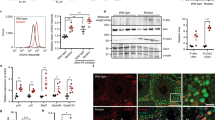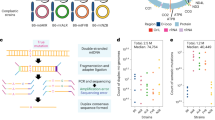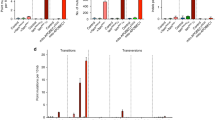Abstract
Mitochondrial DNA (mtDNA) mutations are thought to have a causal role in many age-related pathologies. Here we identify mtDNA deletions as a driving force behind the premature aging phenotype of mitochondrial mutator mice, and provide evidence for a homology-directed DNA repair mechanism in mitochondria that is directly linked to the formation of mtDNA deletions. In addition, our results demonstrate that the rate at which mtDNA mutations reach phenotypic expression differs markedly among tissues, which may be an important factor in determining the tolerance of a tissue to random mitochondrial mutagenesis.
This is a preview of subscription content, access via your institution
Access options
Subscribe to this journal
Receive 12 print issues and online access
$209.00 per year
only $17.42 per issue
Buy this article
- Purchase on Springer Link
- Instant access to full article PDF
Prices may be subject to local taxes which are calculated during checkout


Similar content being viewed by others
References
Linnane, A.W., Marzuki, S., Ozawa, T. & Tanaka, M. Lancet 1, 642–645 (1989).
Kujoth, G.C. et al. Science 309, 481–484 (2005).
Trifunovic, A. et al. Nature 429, 417–423 (2004).
Vermulst, M. et al. Nat. Genet. 39, 540–543 (2007).
Tanhauser, S.M. & Laipis, P.J. J. Biol. Chem. 270, 24769–24775 (1995).
Srivastava, S. & Moraes, C.T. Hum. Mol. Genet. 14, 893–902 (2005).
Schriner, S.E. et al. Science 308, 1909–1911 (2005).
Kujoth, G.C., Bradshaw, P.C., Haroon, S. & Prolla, T.A. PLoS Genet. 3, e24 (2007).
Kraytsberg, Y. et al. Science 304, 981 (2004).
Mita, S. et al. Nucleic Acids Res. 18, 561–567 (1990).
Greaves, L.C. et al. Proc. Natl. Acad. Sci. USA 103, 714–719 (2006).
Khrapko, K., Kraytsberg, Y., de Grey, A.D., Vijg, J. & Schon, E.A. Aging Cell 5, 279–282 (2006).
Kraytsberg, Y. et al. Nat. Genet. 38, 518–520 (2006).
Bender, A. et al. Nat. Genet. 38, 515–517 (2006).
Khaidakov, M., Siegel, E.R. & Shmookler Reis, R.J. Mech. Ageing Dev. 127, 808–812 (2006).
Acknowledgements
This work was supported by grants AG01751 (L.A.L. and P.S.R.), CA102029 and ES11045 (L.A.L.) and AG021905 (T.A.P. and G.C.K.) from the US National Institutes of Health. J.H.B. is a Research Fellow of the Terry Fox Foundation through an award from the National Cancer Institute of Canada. J.W. was supported by the Brookdale Leadership Aging Fellowship. The authors thank R.S. Mangalindan, C. Masuda and N. Ericson for technical assistance.
Author information
Authors and Affiliations
Contributions
M.V. carried out the experiments described in Figures 1a and b, Supplementary Figures 1,2,3,4,5 and Supplementary Tables 1 and 2. M.V. adapted the RMC-assay and wrote the paper. J.W. and M.V. generated Figure 2 and Supplementary Figures 6 and 7. M.V., J.H.B. and L.A.L. conceived the project. J.H.B. performed cell culture and provided technical expertise. G.C.K., T.A.P. and P.S.R. provided animal care, tissues and technical assistance. L.A.L. supervised the experimental work and interpretation of the data. All authors commented on and discussed the paper.
Note: Supplementary information is available on the Nature Genetics website.
Corresponding author
Supplementary information
Supplementary Text and Figures
Supplementary Methods, Supplementary Figures 1–7, Supplementary Tables 1 and 2 (PDF 908 kb)
Rights and permissions
About this article
Cite this article
Vermulst, M., Wanagat, J., Kujoth, G. et al. DNA deletions and clonal mutations drive premature aging in mitochondrial mutator mice. Nat Genet 40, 392–394 (2008). https://doi.org/10.1038/ng.95
Received:
Accepted:
Published:
Issue Date:
DOI: https://doi.org/10.1038/ng.95
This article is cited by
-
NAD+ dependent UPRmt activation underlies intestinal aging caused by mitochondrial DNA mutations
Nature Communications (2024)
-
Sarcopenia: investigation of metabolic changes and its associated mechanisms
Skeletal Muscle (2023)
-
Secondary structure of the human mitochondrial genome affects formation of deletions
BMC Biology (2023)
-
Structural basis for DNA proofreading
Nature Communications (2023)
-
Mitochondrial DNA deletion mutations increase exponentially with age in human skeletal muscle
Aging Clinical and Experimental Research (2021)



